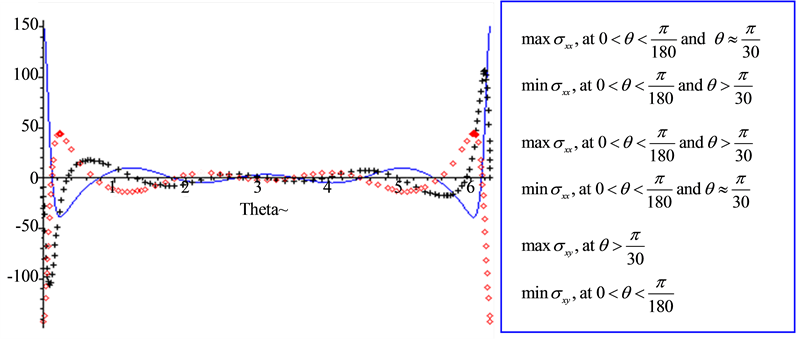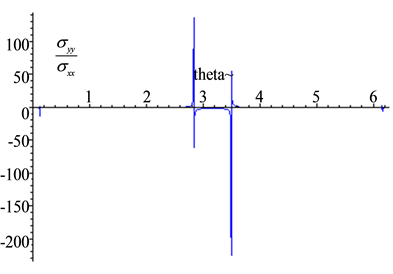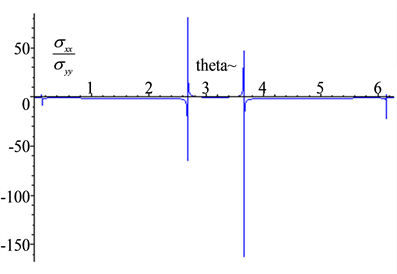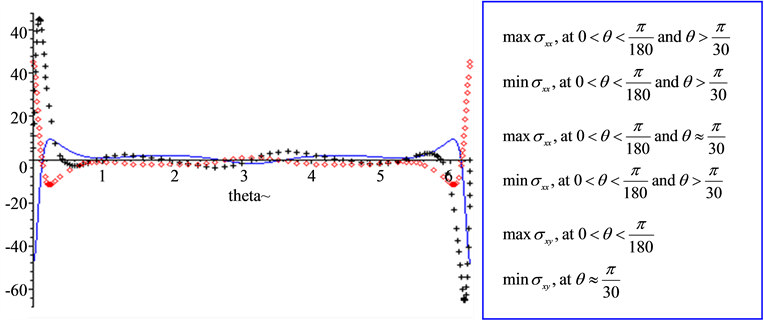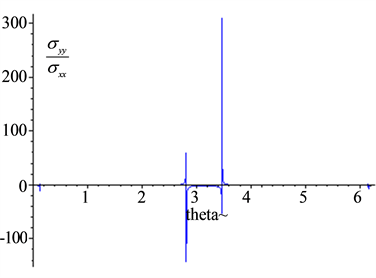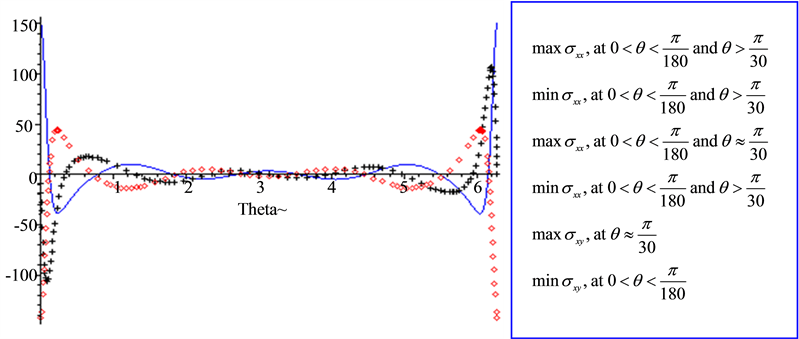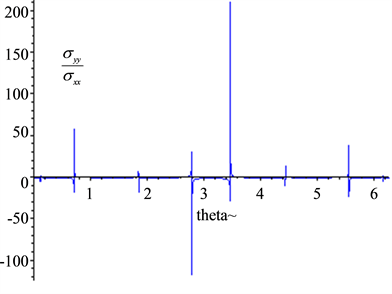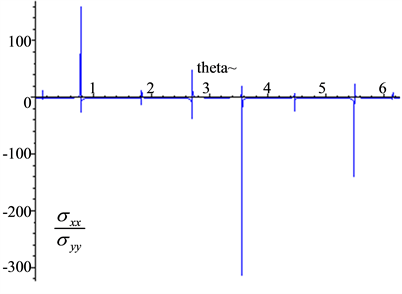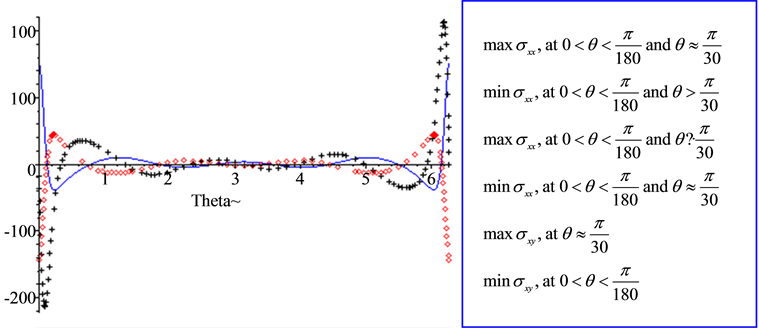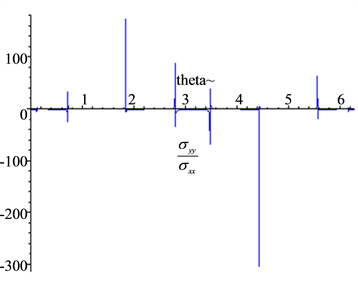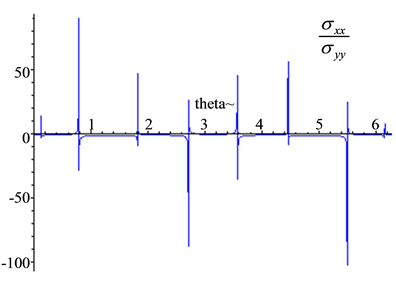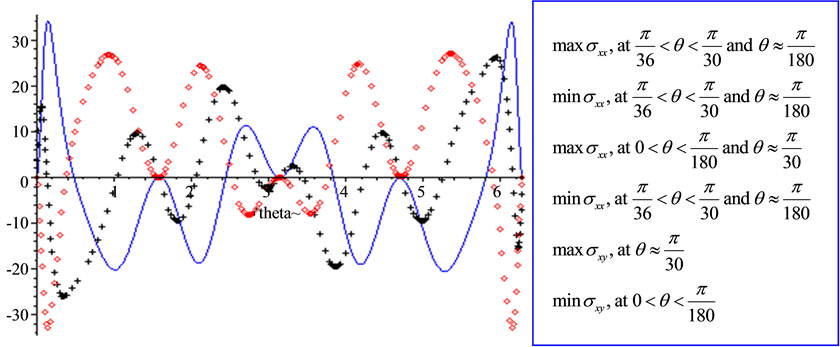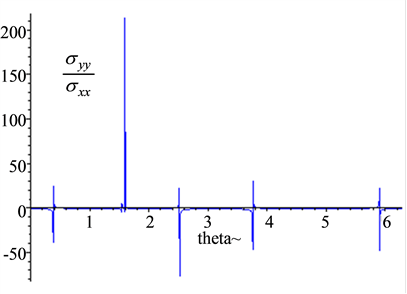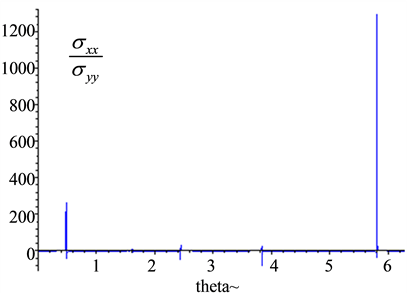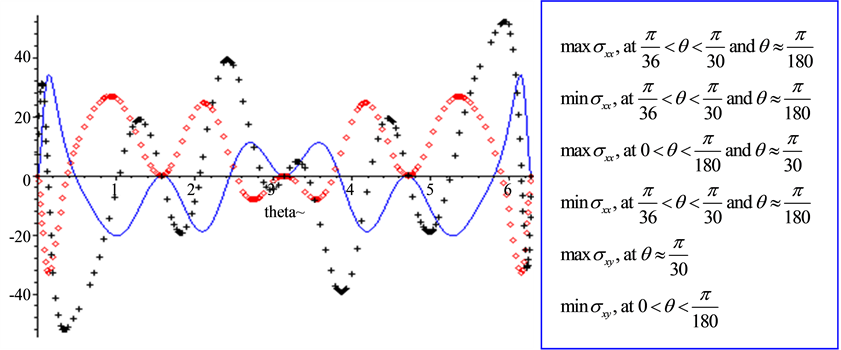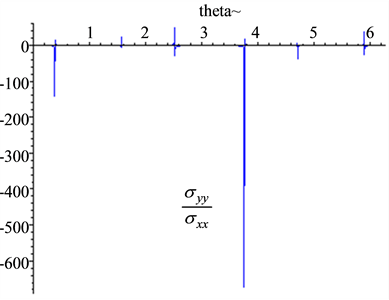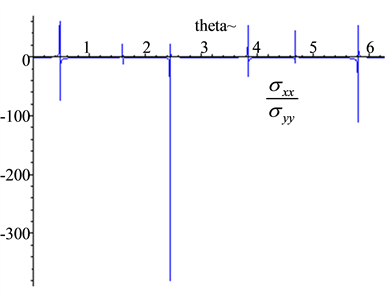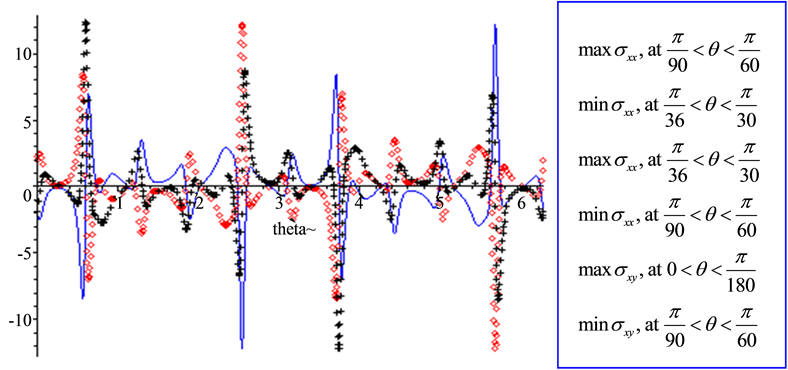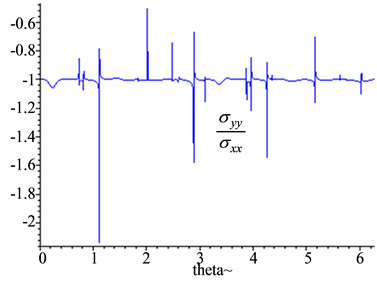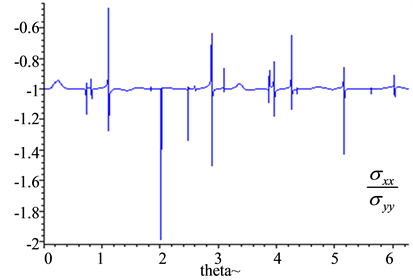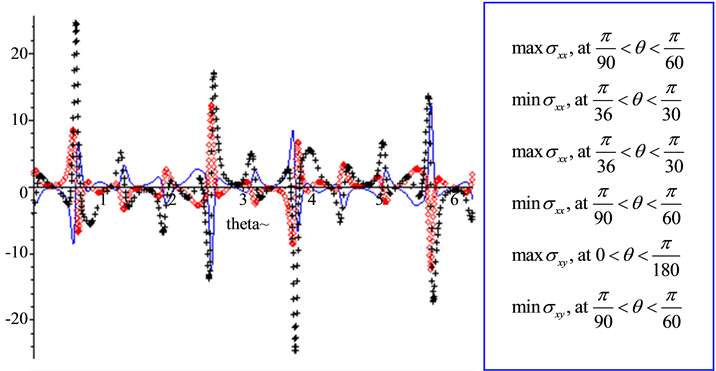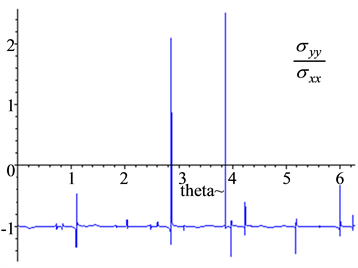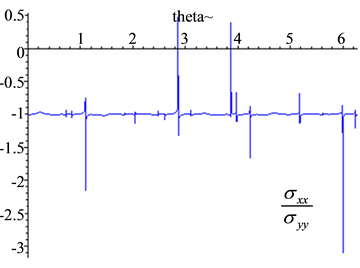Journal of Modern Physics
Vol.06 No.06(2015), Article ID:56761,16 pages
10.4236/jmp.2015.66088
Presence of Heat on an Infinite Plate with a Curvilinear Hole Having Two Poles
F. S. Bayones
Math. Dept., Faculty of Science, Taif University, Taif, KSA
Email: f.s.bayones@hotmail.com
Copyright © 2015 by author and Scientific Research Publishing Inc.
This work is licensed under the Creative Commons Attribution International License (CC BY).
http://creativecommons.org/licenses/by/4.0/



Received 6 March 2015; accepted 25 May 2015; published 28 May 2015
ABSTRACT
In the present paper Cauchy integral methods have been applied to derive exact and expressions for Goursat’s function for the first and second fundamental problems of isotropic homogeneous perforated infinite elastic media in the presence of uniform flow of heat. For this, we considered the problem of a thin infinite plate of specific thickness with a curvilinear hole where the origins lie in the hole is conformally mapped outside a unit circle by means of a specific rational mapping. Moreover, the three stress components ,
,  and
and  of the boundary value problem in the thermoelasticity plane are obtained. Many special cases of the conformal mapping and four applications for different cases are discussed and many main results are derived from the work.
of the boundary value problem in the thermoelasticity plane are obtained. Many special cases of the conformal mapping and four applications for different cases are discussed and many main results are derived from the work.
Keywords:
An Elastic Plate, Presence of Heat, Curvilinear Hole, Cauchey Method, Conformal Mapping

1. Introduction
The boundary value problems for isotropic performed plates have been discussed by several authors. Some authors used Laurant’s theorem [1] -[8] to express each complex potential as a power series, and others [9] -[16] used complex variable method of Cauchy integral. The extensive literature on the isotropic is now available and we can only mention a few recent interesting investigations in refs [17] -[26] .
In thermoelastic problems for elastic media, the first and second boundary value problems are equivalent to two finite analytic functions  and
and  of one complex argument
of one complex argument . These functions must satisfy the boundary condition,
. These functions must satisfy the boundary condition,
 (1)
(1)
where t denotes the affix of a point on the boundary. In terms of ,
,  ,
,  does not vanish or become infinite for
does not vanish or become infinite for , where the infinite region is outside a unit circle
, where the infinite region is outside a unit circle . For the first fundamental boundary value problems or the called stress boundary value problems,
. For the first fundamental boundary value problems or the called stress boundary value problems,  ,
,  is a given function of stress. While for
is a given function of stress. While for ,
,  is a given function of displacement called the thermal conductivity; we have the second fundamental boundary value problems called the displacement boundary value problems.
is a given function of displacement called the thermal conductivity; we have the second fundamental boundary value problems called the displacement boundary value problems.
The complex potential functions 


and,

where, 






for solving the problem of stretching of an infinite plate weakened by an elliptic hole. Sokolonikoff [3] used the same rational mapping of Equation (4) to solve the problem of elliptical ring, where the Laurant’s theorem is used. This transformation of Equation (4) conformally maps the infinite domain bounded internally by an ellipse onto the domain outside the unit circle 



where 

The main reason for interest in this mapping is that the general shape of the hypotrochoids is curvilinear polygons, for n = 1 ellipse, for n = 2 a curvilinear triangle, for n = 3 a curvilinear square… etc. In previous papers (Abdou et al. [9] -[15] [28] [29] ), the complex variable method has been applied to solve the first and second fundamental problems for the same domain of the infinite plate with general curvilinear hole c conformally mapped on the domain outside a unit circle by using respectively, the rational mapping functions



and

In this paper, the complex variable method has been applied to solve the first and second fundamental problems for the same previous domain of the infinite plate with a general curvilinear hole C, with three poles and presence of heat, conformally mapped on the domain outside a unit circle 

where










where n is the unit vector perpendicular to the surface.
Neglecting the variation of the strain and the stress with respect to the thickness of the layer, the thermoelastic potential function 

where 

In this case, formula (1) for the first and second boundary value problems respectively takes the following forms,


where the applied stresses 






where 



where 
The rational mapping 








the last formula represents the first and second boundary value problems in the 
In this study, we use the rational mapping (10) to map the curvilinear hole C of the infinite viscoelastic fluid layer outside a unit circle
2. The Rational Mapping
The mapping function (10) maps the curvilinear hole C in z-plane onto the domain of the outside unit circle in 


3. Method of Solution
In this section, we use the complex variable method to obtain the two complex functions (Goursat functions) 





By substituting Equation (19) in Equation (11) and using the definition of 

Also, the stresses components can be adapted in the forms,


and,

By using Equation (19) and Equation (20), Equations (21)-(23) becomes


and,
Figure 1. The different shapes of the rational mapping (10).
Figure 1. The different shapes of the rational mapping (10).

where,

After determining the Goursat functions the components of stress are completely determined.
Using Equation (8), the expression 

where,






Using Equation (2) and Equation (3) in Equation (18), we get

using Equation (29) in Equation (31), we have

taking 

where,



and,

Assume that the function 


ation (35) by 



using Equations (35)-(39) in Equation (40) then applying the properties of Cauchy integral to have

where,

The formula (41) represents the integro-differential equation of the second kind with Cauchy kernel.
To obtain the integral in terms of Equation (41) we use Equation (29) and then apply the residue theorem to have,

where 
Also,

So, Equation (41) reduce to,

Differentiating Equation (45) with respect to 

where,

Hence, we have

where,

Also, from the boundary condition (35), 

where,





and,

4. Special Cases
Now, we are in a position to consider several cases:
1) For

2) For

3) For

mapping is that the general shapes of the hypotrochids are curvilinear polygons, for 


5. Some Applications
In this section, we assume different values of the given function in the first or second fundamental boundary value problems. Then, we obtain the expression of Goursat functions. After that, the components of stresses can be calculated directly.
Figure 2. The different shapes of the rational mapping in (1).
Figure 2. The different shapes of the rational mapping in (1).
Figure 3. The different shapes of the rational mapping in (2).
Figure 3. The different shapes of the rational mapping in (2).
Figure 4. The different shapes of the rational mapping in (3).
Figure 4. The different shapes of the rational mapping in (3).
1. Application 1: When the curvilinear centre is not allowed to rotate. At
For
Goursat’s functions in Equations (45) and (50) take the form


where,

This application discusses the first fundamental boundary value problem of an infinite layer stretched at infinity by the application of a uniform tensile stress of intensity heat in the negative direction of y-axis. This layer is weakened by a curvilinear hole C which is free from stress.
For






1) In the thermoelasticity layer, we have the following shapes for the stress components by using the substitutions




2) When the study is in the normal layer, we have the following shapes for the stress components, see Figure 7 and Figure 8.
Figure 5. The relation between components of stresses and the angle made on the x-axis. 


Figure 6. The ratio of vertical to horizontal stresses.
Figure 7. The relation between components of stresses and the angle made on the x-axis. 


Figure 8. The ratio of vertical to horizontal stresses.
2. Application 2: Bi-axial tension
For
Goursat’s functions in Equations (45) and (50) take the form


where,

This application discusses the first fundamental boundary value problem of an infinite layer stretched at infinity by the application of a uniform tensile stress of intensity heat in the negative direction of y-axis. This layer is weakened by a curvilinear hole C which is free from stress.
For






1) In the thermoelasticity layer, we have the following shapes for the stress components by using the substitutions




Figure 9. The relation between components of stresses and the angle made on the x-axis. 


Figure 10. The ratio of vertical to horizontal stresses.
2) When the study is in the normal layer, we have the following shapes for the stress components, see Figure 11 and Figure 12.
3. Application 3: When a couple with a given moment acting on the curvilinear hole and the stresses vanishing at infinity
For
Goursat’s functions in Equations (45), (50) take the form


where,

Figure 11. The relation between components of stresses and the angle made on the x-axis. 


Figure 12. The ratio of vertical to horizontal stresses.
This application discusses the first fundamental boundary value problem of an infinite layer stretched at infinity by the application of a uniform tensile stress of intensity heat in the negative direction of y-axis. This layer is weakened by a curvilinear hole C which is free from stress.
For






1) In the thermoelasticity layer, we have the following shapes for the stress components by using the substitutions




2) When the study is in the normal layer, we have the following shapes for the stress components, see Figure 15 and Figure 16.
4. Application 4: The external force acts on the center of the curvilinear hole
For


where,

Figure 13. The relation between components of stresses and the angle made on the x-axis. 


Figure 14. The ratio of vertical to horizontal stresses.
Figure 15. The relation between components of stresses and the angle made on the x-axis. 


This application discusses the first fundamental boundary value problem of an infinite layer stretched at infinity by the application of a uniform tensile stress of intensity heat in the negative direction of y-axis. This layer is weakened by a curvilinear hole C which is free from stress.
For







1) In the thermoelasticity layer, we have the following shapes for the stress components by using the substitutions




2) When the study is in the normal layer, we have the following shapes for the stress components, see Figure 19 and Figure 20.
Figure 16. The ratio of vertical to horizontal stresses.
Figure 17. The relation between components of stresses and the angle made on the x-axis. 


Figure 18. The ratio of vertical to horizontal stresses.
Figure 19. The relation between components of stresses and the angle made on the x-axis. 


Figure 20. The ratio of vertical to horizontal stresses.
6. Conclusions
From the previous discussions we have the following results:
1) We find that the effect of heat is very clear; we find that the values of components stress are reduced with existence of heat, while at absence of heat we find the values of components of stresses are increasing.
2) With increasing angle and with absence
and,
3) With increasing angle and with existence
and,
4) The components of stresses effected are clear by increasing the values of
References
- England, A.H. (1971) Complex Variable Methods in Elasticity. John Wiley Sons Ltd., London, New York.
- Kalandiya, A.I. (1975) Mathematical Method of Two-Dimensional Elasticity. Mir Publishers, Moscow.
- Sokolnikff, I.S. (1950) Mathematical Theory of Elasticity. New York.
- Abd-Alla, A.M. (2013) Journal of Computational and Theoretical Nanoscience, 10, 1914-1920. http://dx.doi.org/10.1166/jctn.2013.3148
- Narayanan, M. and Peter, A.J. (2012) Quantum Matter, 1, 53-58. http://dx.doi.org/10.1166/qm.2012.1005
- Bhattacharya, P.S. and Ghatak, K.P. (2012) Quantum Matter, 1, 63-85. http://dx.doi.org/10.1166/qm.2012.1007
- Kalandiya, A.I. (1975) Mathematical Theory of Elasticity. Mir Publishers, Moscow.
- Muskhelishvili, N.I. (1953) Some Basic Problems of Mathematical Theory of Elasticity. Noordhoff International, Leyden.
- Abdou, M.A. and Kkhar El-din, E.A. (1994) Journal of Computational and Applied Mathematics, 56, 341-361. http://dx.doi.org/10.1016/0377-0427(94)90088-4
- Abdou, M.A. (2002) Applied Mathematics and Computation, 125, 177-193. http://dx.doi.org/10.1016/S0096-3003(00)00118-1
- Abdou, M.A. and Asseri, S.A. (2009) Journal of Thermal Stresses, 32, 1126-1148.
- Abdou, M.A. and Asseri, S.A. (2009) Applied Mathematics and Computation, 212, 23-36. http://dx.doi.org/10.1016/j.amc.2009.01.079
- Sabbah, A.S., Abdou, M.A. and Ismail, A.S. (2002) Proceeding Mathematical Physics Society Egypt, 34, 15-27.
- Parkus, H. (1976) Thermoelasticity. Springer Verlag, Berlin. http://dx.doi.org/10.1007/978-3-7091-8447-9
- El-Sirafy, I.H. and Abdou, M.A. (1984) Journal of Mathematical and Physical Sciences, 18, 205-214.
- Abdou, M.A. and Khamis, A.K. (2000) Bulletin of Calcutta Mathematical Society, 29, 313-326.
- El-Naggar, A.M., Kishka, Z., Abd-Alla, A.M., Abbas, I.A., Abo-Dahab, S.M. and Elsagheer, M. (2013) Journal of Computational and Theoretical Nanoscience, 10, 1408-1417. http://dx.doi.org/10.1166/jctn.2013.2862
- Abd-Alla, A.M. and Yahya, G.A. (2013) Journal of Computational and Theoretical Nanoscience, 10, 750-755. http://dx.doi.org/10.1166/jctn.2013.2765
- Abd-Alla, A.M., Abo-Dahab, S.M., Al-Thamali, T.A. and Mahmoud, S.R. (2013) Journal of Computational and Theoretical Nanoscience, 10, 297-305. http://dx.doi.org/10.1166/jctn.2013.2695
- Abd-Alla, A.M., Yahya, G.A. and El-Thagafy, M.H. (2013) Journal of Computational and Theoretical Nanoscience, 10, 347-352. http://dx.doi.org/10.1166/jctn.2013.2703
- Abd-Alla, A.M., Yahya, G.A. and Mahmoud, S.R. (2013) Journal of Computational and Theoretical Nanoscience, 10, 455-463. http://dx.doi.org/10.1166/jctn.2013.2718
- Abd-Alla, A.M. and Ahmed, S.M. (1996) Earth, Moon, and Planets, 75, 185-197. http://dx.doi.org/10.1007/BF02592996
- Abd-Alla, A.M., Abo-Dahab, S.M. and Al-Thamali, T.A. (2012) Journal of Mechanical Science and Technology, 26, 2815-2823. http://dx.doi.org/10.1007/s12206-012-0736-5
- Bose, P.K., Paitya, N., Bhattacharya, S., De, D., Saha, S., Chatterjee, K.M., Pahari, S. and Ghatak, K.P. (2012) Quantum Matter, 1, 89-126. http://dx.doi.org/10.1166/qm.2012.1009
- Tüzün, B. and Erkoç, C. (2012) Quantum Matter, 1, 136-148. http://dx.doi.org/10.1166/qm.2012.1012
- Ono, T., Fujimoto, Y. and Tsukamoto, S. (2012) Quantum Matter, 1, 4-19. http://dx.doi.org/10.1166/qm.2012.1002
- Muskhelishvili, N.I. (1949) Some Basic Problems of the Mathematical Theory of Elasticity. Nauka, Moscow.
- Abdou, M.A. (1994) Alexandria Engineering Journal, 33, 227.
- Abdou, M.A. and Badr, A.A. (1999) Journal of the Indian Academy of Wood Science, 51, 155-166.



